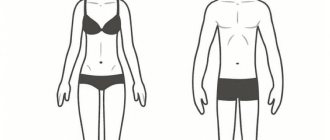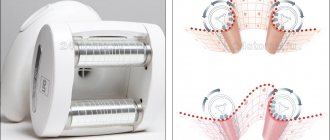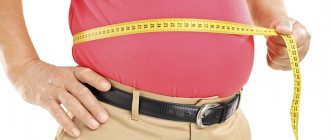Waist-hip ratio (English abbreviation WHR, which can be translated as THR - waist-hip ratio) is the ratio of the circumference at the waist to the circumference at the hips.
There is actually no such generally accepted abbreviation as TBS
This indicator is very popular in the West, where a lot of research has been conducted on its effect on attractiveness, as well as as an indicator of health.
How to measure your waist and hip circumference correctly
There are rules developed by different organizations to make these measurements correctly. While everything is simple with hips, when measuring the waist, different organizations use slightly different measurement standards.
Measuring the hips and waist: for a thin person (left), the waist should be measured correctly at the narrowest point, while for a fuller person (right) it should be measured approximately 2 cm above the navel. The hips are measured at their widest part, regardless of the figure (approximately in the middle).
Waist and hip measurement rules used by world-famous organizations
According to the World Health Organization (WHO) protocol, waist circumference should be measured midway between the lower edge of the lower rib and the top of the iliac crest (the upper pelvic bone, seen from the side). A measuring tape is used for this (colloquially “centimeter”). When tightened, it should create a pressure equivalent to 100 grams. Hip circumference should be measured around the widest part of the buttocks, using the same tape, parallel to the floor.
The US National Institutes of Health and the National Nutrition Examination Program use results obtained by measuring at the top of the iliac crest—essentially where we typically have the waistband of standard pants.
Often, non-professionals measure the waist at the level of the navel, but studies have shown that this method can often result in an understatement of its actual circumference.
When measuring both circumferences, the person should have their feet side by side, arms apart, body weight evenly distributed, and no excess clothing. Breathing should be normal, calm, and measurements should be taken at the end of exhalation. Each measurement is repeated twice, and if there is a centimeter difference between them, then the average results are taken.
The easiest way to measure your waist and hips correctly
In practice, in order not to delve into all these subtleties, the waist with a slender figure is most correctly measured simply in the area of its smallest circumference, as a rule, slightly above the navel. In cases where the waist is convex rather than concave, for example, as happens during pregnancy or when you are overweight, the location of the smallest circumference is often more difficult to determine. In such cases, to determine the degree of obesity, a measurement is taken a couple of centimeters above the navel. Hip circumference can be measured simply visually at the widest part of the buttocks.
Do not forget that these are the rules for taking measurements to determine the degree of obesity and other health indicators, and not for sewing or selecting clothes.
Waist to hip ratio in a healthy person
Waist-to-hip ratio is used as an indicator and measure of a person's health. Using this coefficient, you can see the degree of risk of developing serious diseases. Research shows that people with an apple body shape (waist wider than the hips) face greater health risks than those with a pear body shape, whose hips are wider than the waist.
This ratio is also used to determine obesity, which in turn serves as an indicator of other more serious diseases.
WHO states that abdominal obesity occurs when a waist-to-hip ratio is greater than 0.90 for men and 0.85 for women, or a body mass index (BMI) greater than 30.0. According to the National Institute of Diabetes and Digestive and Kidney Diseases (NIDDK), women who have a THR greater than 0.8 and men who have it greater than 1.0 are at increased health risk.
HBS is a better predictor of life expectancy in older people than waist circumference or BMI (body mass index). But if obesity is determined by this indicator, instead of BMI, then the number of people in the world who are at increased risk of a heart attack will decrease by three times. Waist-to-hip ratio is considered to more accurately indicate the percentage of body fat relative to body weight than waist circumference or BMI. Of these three values, only TBS takes into account differences in body structure (muscle mass, bone width, fat). Thus, it is possible for two women to have completely different weights but the same waist-to-hip ratio, or to have the same BMI but completely different waist-to-hip ratios.
Even in ancient civilizations around the world, ideal women were most often represented with a TBC in the range of 0.6-0.7. Simply put, a woman who had much wider hips than her waist was considered more beautiful. Most likely, this is explained by the subconscious understanding of men that a woman with wide hips is more predisposed to having children. But more about this later in the article.
According to some studies, WBS is a better predictor of your chances of developing cardiovascular disease than waist circumference and body mass index. But others show that waist circumference is a more accurate indicator of cardiovascular risk factors, body fat distribution and hypertension in people with type 2 diabetes. Therefore, it is impossible to say for sure which of these indicators can tell more about health.
Celebrities with a waist of 80 cm or more
Recently, in the wake of the popularity of body positivity, not only women with ideal figures are becoming popular. Nowadays you can find quite a lot of actresses, singers and other popular women who have a waist of 80 centimeters or more.
- Queen Lattifa. With a height of 171 cm, the star weighs about 90 kg and has a waist size of 102 cm. This American actress, model and singer was nominated for an Emmy and an Oscar, received a Golden Globe and a Grammy. She is not at all shy about her figure and is proud of every kilogram.
- Singer Adele, with a height of 175 cm, weighs 88 kg, and her waist size is 81 cm. The owner of a unique voice and winner of many Grammy awards used to weigh even more. Lately she has managed to lose weight, but she still doesn’t fit into the usual beauty standards.
- Melissa McCarthy stars in the TV series Mike and Molly and the film Catch the Fat Lady If You Can. With a height of 157 cm, she weighs 88 kg, and her waist size is 88 cm. The actress released her own clothing line for obese women, while she lost more than 30 kg and continues to work on herself.
- Ekaterina Skulkina comes to mind immediately when we think of curvy Russian celebrities. Her height is 180 cm, weight is 94 kg, and her waist circumference exceeds 80 cm. But this does not stop Ekaterina from shining in Comedy Woman.
- Eva Polna. The famous lead singer of the group Guests from the Future weighs 82 kg with a height of 172 cm. At different periods of her life, Eva lost weight and gained weight again, but she was never skinny.
- Svetlana Permyakova. Svetlana became the star of the series Interns just at the time when she had curvaceous figures. Now the star has lost several tens of kilograms, but in the memory of many people she will remain as a curvaceous nurse.
You can be inspired by the curvaceous figures of celebrities, but you must not forget about health.
Every woman who monitors her health must control not only her weight, but also her body volume, hudeem-bez-problem.ru is sure. It is especially important to control your waist circumference, since this is where abdominal fat accumulates, which is a dangerous symptom for a woman. If you notice that your waist is getting bigger, change your lifestyle, start exercising and eating right. If this does not help, consult an endocrinologist.
Author - Yulia Mosalova, checked by practicing family doctor Elizaveta Anatolyevna Krizhanovskaya. For more information about the experts, see the site authors
- 4
- 39
Waist and hip volume as an indicator of reproduction
A THR of 0.7 for women and 0.9 for men has been shown to be closely associated with overall health and the ability to give birth or conceive a child. Women with a TPS of around 0.7 have optimal estrogen levels and are less susceptible to underlying diseases such as diabetes, cardiovascular disease and ovarian cancer. Women with a high waist-to-hip ratio (0.80 or higher) have a significantly lower chance of becoming pregnant than those with a WHR of 0.70-0.79, regardless of their BMI. Men with a TPS of around 0.9 similarly have a better chance of conceiving and are also less likely to get prostate and testicular cancer.
Research shows that the ratio of waist to hip length is an accurate indicator of reproductive health, in terms of the body's production of the necessary hormones for this. Among girls with the same weight, with lower TBS rates, puberty occurs earlier. This is manifested in the growth of luteinizing hormone (LH) and follicle-stimulating hormone (FSH), as well as the sex steroid hormone - estradiol.
A Dutch prospective (with a selected group of people) study of artificial insemination confirmed an increase in the chances of getting pregnant with low TBS back in 1993. It showed that with an increase of 0.1 unit of hip joint, it reduces the likelihood of conception in a cycle by 30%. This is adjusted for age, weight, reasons for artificial insemination, length and regularity of cycles, and smoking.
A woman’s waist is more than 80 centimeters: what diseases can manifest themselves?
Thanks to the observations of scientists, doctors began to identify various diseases in the initial stages. After all, just by a person’s appearance one can determine what pathologies he is prone to. When a woman’s waist is more than 80 centimeters, one can already suspect that there are risks of high blood pressure, increased cholesterol in the bloodstream, and increased blood sugar. What’s worst is that recently diseases such as myocardial infarction and stroke have become “younger”. Already at the age of 37, these pathologies can be transferred.
Obesity is the cause of diabetes
The influence of mother's waist and hip size on child's cognitive abilities
American scientists even studied the relationship between the cognitive abilities (roughly speaking, thinking) of young children and the waist-to-hip ratio of their mothers (WHR). As a result of the tests, it was found that children whose mothers had wider hips and smaller hip joints were more mentally developed. This is explained by the fact that the fetus received additional long-chain polyunsaturated acids from the fat on the mother's thighs. In addition, statistics also show that children of girls with low TBS who became mothers in adolescence were more protected from cognitive impairment associated with having a child at too young an age.
What determines the size of the waist and hips
Twin studies have shown that 22-61% of waist-to-hip ratios can be explained by genetic factors. Among other factors, nutrition and lifestyle occupy the first places.
Waist size standards for women and men of different races
- Representatives of the Caucasian race are allowed to have a waist size of up to 80 centimeters (women), up to 94 centimeters (men) .
- For Americans, women's waist size should be no higher than 88 centimeters, and for men: 109 centimeters .
- Asians are considered overweight if the waist for women exceeds 73-79 centimeters, and for men 86 centimeters .
Of course, the parameters differ a little and this has more to do with the structural features of the body of a particular race.
Ideal waist to hip ratio
Some researchers have found that waist-to-hip ratio (WHR) is an important measure of female attractiveness. Women with a TBI of 0.7 tend to be rated as more attractive by men from Indo-European cultures. Tastes can vary, according to some studies, from 0.6 (in China, South America, and parts of Africa) to 0.8 (in Cameroon and the Hazda tribe of Tanzania), with diverging preferences depending on ethnicity.
It seems that men pay more attention to a woman's waist size than her hip size. The Journal of Biological Psychology had this to say about this:
“The size of your hips and waist indicates the amount of extra fat that can be used as an energy source. The waist conveys information such as current reproductive status or health conditions... in Western countries where there are no seasonal food shortages, the waist, conveying information about fertility and health status, will be more important than hip size in assessing female attractiveness."
In less wealthy and developed countries, women have a higher number of pregnancies, health burdens from parasites, and consume less high-calorie food. In this regard, women with a higher TBC are often considered more attractive there. This also affects the difference in the age at which marriageable age and peak birth rates fall in such countries.
Thus, the size of the hip joint, which indicates the onset of puberty, sexuality, reproduction, hormonal disorders and distinguishes a man from a woman, differs in different populations.
What to do, how to reduce your waist?
Many women with a waist larger than 80 centimeters are lazy to take care of their bodies and their health. Since they often do not see a problem in the increased volumes, they think that someday they will definitely take it and get in shape. But there are more important and urgent problems, and the fat on the waist does not disappear anywhere.
Therefore, the first thing to do is to realize that the problem exists, and it will not go away on its own. Next, you should follow the recommendations of doctors, which are described below.
A professional nutritionist will select an individual diet and give nutritional advice
- Start playing any sport. Let it be walking, dancing or cycling. The main thing is that the body receives additional stress and burns fat during training.
- If you have absolutely no experience in playing sports, then first visit a physical therapy specialist. He will help you choose exercises that you can perform without additional exercise equipment, but at the same time your heart rate will be in the fat-burning zone during work.
- Nutrition must become correct. Completely give up fried, smoked, sweets, fast food and everything that leads to excess weight gain. The basis of the diet should be vegetables, herbs, lean meat and complex carbohydrates. But there is no need to adhere to any special diet.
- If you find it difficult to develop a diet on your own, consult a nutritionist. He will help you create a healthy menu taking into account your wishes.
- Follow all the recommendations of the endocrinologist, do not forget to take the medications he prescribes.
- In some particularly advanced cases, surgery may be necessary to reduce the volume of the stomach. But try not to bring it to this state, because surgery is always stressful for the body.
Your main goal is not to lose weight, but to improve metabolic processes. Healthy food and regular physical activity will improve your overall health and help you remove belly fat, hudeem-bez-problem.ru is sure.
Diet option for a thin waist and flat stomach
The influence of waist-to-hip ratio on attractiveness (research results)
The concept and meaning of TBS as an indicator of attractiveness was first described in 1993 by an American psychologist named Devendra Singh. He argued that this ratio is a more consistent measure of estrogen than the bust-waist ratio (BWR).
In a series of studies conducted by Singh (1993), participating men used a woman's HB and body fat distribution to determine her attractiveness. The men were shown a series of 12 drawings of women with different HB scores and the distribution of fat in their body. Women in the drawings with normal fat distribution and moderate TBS were associated with the most positive traits (i.e., sexy, smart, and healthy). When considering the depicted women with low TBS (small difference between the waist and hips), other than youth, men did not associate them with anything positive.
In this study, Singh suggested that men and women may have developed innate mechanisms that detect and use waist-to-hip ratio to assess how healthy a person is. Having a certain waist-to-hip ratio increases the chances of getting healthy offspring with hereditary genetic protection against various diseases.
Other studies have found that TJ is a sign of attractiveness that goes beyond just fat and fertility. For example, a study was conducted using eye tracking techniques on men while they digitally manipulated the same woman. In addition to eye tracking, subjects were also asked to rate the image based on attractiveness. Although men fixed their eyes during the study mainly on women's breasts, regardless of its size, they called the most attractive a woman with a TBC of 0.7.
In addition, a study was conducted by Joson and Tazinari in 2005. The reaction to an animated human walking was considered. It turns out that men not only use TBS to evaluate attractiveness, but also as a means to determine sexual differences. At the same time, a person with a higher waist-to-hip ratio is perceived as more masculine. And with a lower value, when the hips are not so noticeably wider than the waist, the object seems more feminine and gentle. The authors of this study suggest that this provides an additional explanation for why men perceive lower TBI as more attractive. It was also concluded that for this reason, men who have a smaller hip joint feel less confident and independent than men with a higher and more courageous hip joint.
To increase attractiveness, some women artificially change their waist-to-hip ratio. These methods include using a corset to reduce the size of the waist and visually increase the apparent size of the hips and buttocks. During various such attempts during the 20th century, manufacturers used sizing calculations called hipspring, which translated means “spring hips” or “spring hips,” to make corsets. In this case, the height of the part of the corset for tightening the waist was calculated by subtracting the waist size from the hip size. However, this method of calculating sizes fell out of use because it often gave a poor indicator of attractiveness. For example, a size 10 inches (250 mm height of the corset) will look very attractive on an adult woman with average parameters, but a child or small woman with a corset of this size will look like an undernourished person.
In the case of TBS, the brain evaluates the level of attractiveness based on the ability to reproduce offspring (reproductivity), and on the presence of fat in the body. This was confirmed by one interesting American study. The computer simulated female bodies with real height and body weight (BMI), but an irregular body shape (BBS), and then vice versa. Twelve trial participants (6 men and 6 women) were observed using MRI (magnetic resonance imaging) as they looked at these different female forms. Based on the reaction of brain areas, it turned out that the level of attractiveness depends directly on BMI, and not on the waist-hip index (WHI). It was the ratio of weight and height that was responsible for the reactions in the brains of people who evaluated simulated female figures. This study also showed that judgment of ideal body shape may differ among people with eating disorders.
There was also one study conducted in 1995 regarding waist-to-hip ratio. It was attended by 137 Englishmen aged from 16 to 67 years, among them 98 women. As a result, we got a very banal result, which could have been said without research. It turned out that the attractiveness of a woman's breasts depends on the amount of fat in her body and her waist-to-hip ratio. Although most previous studies have shown that young women rate body ideality only on the basis of a slim figure, large breasts only modestly increase their femininity and health attributes. Even in this study, a figure with a high hip (without much difference in waist and hips) and large breasts was rated as the least attractive and healthy by all participants.
The waist-to-hip ratio is an indicator of a person's gender expression. For example, women with a high indicator, and men with a low one, are usually rated less attractive by the opposite sex.
The effect of nutrition on fat deposition in the waist and hips
There have been a number of studies examining the effect of diet on changes in waist circumference, taking into account body mass index. Below are the main results.
A diet of whole grain barley flakes reduces levels of “bad cholesterol” (low-density lipoprotein) as well as waist size in overweight and obese adults. This diet performed better in studies than a low-fiber diet. There was no difference in total weight loss between the groups on these two diets.
There was a more than 3-fold reduction in excess waist fat in people over a year who switched to a diet that included plenty of fruits, vegetables, low-fat dairy products and whole grains. What else was accompanied by a decrease in the amount of baked goods, processed meats, fast food and carbonated sweet drinks in the diet.
A 2011 study showed that a diet high in fruit and dairy products, and low in white bread, meat, margarine and soft drinks, may help prevent abdominal fat accumulation.









